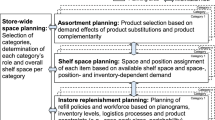Abstract
Retail shelf space allocation problem is well known in literature. In this paper, we make three contributions to retail shelf space allocation problem considering space elasticity (SSAPSE). First, we reformulate an existing nonlinear model for SSAPSE to an integer programming (IP) model using piecewise linearization. Second, we show that the linear programming relaxation of the proposed IP model produces tight upper bound. Third, we develop a heuristic that consistently produces near optimal solutions for randomly generated instances of problems with size (products, shelves) varying from (25, 5) to (200, 50) within a minute of CPU time.
Similar content being viewed by others
References
Anderson, E. E. (1979). An analysis of retail display space: theory and methods. The Journal of Business, 52(1), 103–118.
Anderson, E. E., & Amato, H. N. (1974). A mathematical model for simultaneously determining the optimal brand-collection and display-area allocation. Operations Research, 22(1), 13–21.
Bai, R. (2005). An investigation of novel approaches for optimizing retail shelf-space allocation. An unpublished Ph.D. Thesis, University of Nottingham, UK.
Bai, R., & Kendall, G. (2007). A model for fresh produce shelf space allocation and inventory management with freshness condition dependent demand. INFORMS Journal on Computing. http://www.informs.org/site/IJOC/index.php?c=10&kat=Future+Issues.
Bai, R., Burke, E. K., & Kendall, G. (2007). Heuristic, Meta-heuristic and Hyper-heuristic approaches for fresh produce inventory control and shelf space allocation. Journal of the Operational Research Society, 1–11. doi:10.1057/palgrave.jors.2602463.
Bookbinder, J. H., & Zarour, F. H. (2001). Direct product profitability and retail shelf-space allocation models. Journal of Business Logistics, 22(2), 183–208.
Borin, N., & Farris, P. (1995). A sensitivity analysis of retailer shelf management models. Journal of Retailing, 71(2), 153–171.
Borin, N., Farris, P. W., & Freeland, J. R. (1994). A model for determining retail product category assortment and shelf space allocation. Decision Sciences, 25(3), 359–384.
Bultez, A., & Naert, P. (1988). SH.A.R.P.: Shelf allocation for retailers’ profit. Marketing Science, 7(3), 211–231.
Bultez, A., Naert, P., Gijsbrechts, E., & Abelle, P. V. (1989). Asymmetric cannibalism in retail assortments. Journal of Retailing, 65(2), 153–192.
Cairn, J. P. (1963). Allocate space for maximum profits. Journal of Retailing, 39(2), 43.
Corstjens, M., & Doyle, P. (1981). A model for optimizing retail space allocations. Management Science, 27(7), 822–833.
Corstjens, M., & Doyle, P. (1983). A dynamic model for strategically allocating retail space. The Journal of the Operational Research Society, 34(10), 943–951.
Cox, K. K. (1970). The effect of shelf space upon sales of branded products. Journal of Marketing Research (JMR), 7(1), 55–58.
Curhan, R. C. (1972). The relationship between shelf space and unit sales in supermarkets. Journal of Marketing Research (JMR), 9(4), 406–412.
Drèze, X., Hoch, S. J., & Purk, M. E. (1994). Shelf management and space elasticity. Journal of Retailing, 70(4), 301–326.
Frank, R. E., & Massy, W. F. (1970). Shelf position and space effects on sales. Journal of Marketing Research, 7(1), 59–66.
Gochet, W., & Smeersy, Y. (1979). Reversed geometric programming: a branch-and-bound method involving linear sub problems. Operations Research, 27(5), 982–996.
Hansen, P., & Heinsbroek, H. (1979). Product selection and space allocation in supermarkets. European Journal of Operational Research, 3(6), 474–484.
Hariga, M. A., Al-Ahmari, A., & Mohamed, A. A. (2007). A joint optimisation model for inventory replenishment, product assortment, shelf space and display area allocation decisions. European Journal of Operational Research, 181(1), 239–251.
Hwang, H., Choi, B., & Lee, M. (2005). A model for shelf space allocation and inventory control considering location and inventory level effects on demand. International Journal of Production Economics, 97(2), 185–195.
Irion, J., Al-Khayyal, F., & Lu, J.-C. (2004). A piecewise linearization framework for retail shelf space management models. Technical Report, School of Industrial and Systems Engineering, Georgia Institute of Technology, Atlanta, GA 30332-0205. http://www.optimization-online.org/DB_FILE/2004/10/967.pdf.
Kotzan, J. A., & Evanson, R. V. (1969). Responsiveness of drug store sales to shelf space allocations. JMR, Journal of Marketing Research, 6(4), 465–469.
Laarhoven, P. J. M. V., & Aarts, E. H. L. (1987). Simulated annealing: theory and applications. Dordrecht: Kluwer Academic.
Lim, A., Rodrigues, B., & Zhang, X. (2004). Metaheuristics with local search techniques for retail shelf-space optimization. Management Science, 50(1), 117–131.
Martello, S., & Toth, P. (1990). Knapsack problems: algorithms and computer implementations. New York: Wiley. ISBN:0-471-92420-2.
Owen, J. H., & Mehrotra, S. (2002). On the value of binary expansions for general mixed-integer linear programs. Operations Research, 50(5), 810–819.
Reyes, P. M., & Frazier, G. V. (2007). Goal programming model for grocery shelf space allocation. European Journal of Operational Research, 181(2), 634–644.
Urban, T. L. (1998). An inventory-theoretic approach to product assortment and shelf-space allocation. Journal of Retailing, 74(1), 15–35.
Urban, T. L. (2002). The interdependence of inventory management and retail shelf management. International Journal of Physical Distribution & Logistics Management, 32(1), 41–58.
Yang, M. (2001). An efficient algorithm to allocate shelf space. European Journal of Operational Research, 131(1), 107–118.
Yang, M., & Chen, W. (1999). A study on shelf space allocation and management. International Journal of Production Economics, 60–61, 309–317.
Zufryden, F. S. (1986). A dynamic programming approach for product selection and supermarket shelf-space allocation. The Journal of the Operational Research Society, 37(4), 413–422.
Author information
Authors and Affiliations
Corresponding author
Rights and permissions
About this article
Cite this article
Gajjar, H.K., Adil, G.K. A piecewise linearization for retail shelf space allocation problem and a local search heuristic. Ann Oper Res 179, 149–167 (2010). https://doi.org/10.1007/s10479-008-0455-6
Published:
Issue Date:
DOI: https://doi.org/10.1007/s10479-008-0455-6




